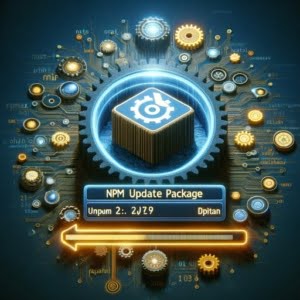NPM Package Update Methods | Reference Guide

At IOFLOOD, we’ve encountered the challenge of keeping our npm packages up to date to ensure our projects run smoothly. To address this, we’ve compiled a guide detailing various methods to update npm packages. By following these straightforward instructions, you’ll learn practical techniques to keep your dependencies current and avoid potential issues caused by outdated packages.
This guide will walk you through the process of updating npm packages, covering everything from basic commands to advanced options. Whether you’re a novice just getting your hands dirty or an experienced developer looking to refine your package management skills, this article promises to be an invaluable resource.
Let’s simplify the process of updating npm packages together and keep our projects running smoothly!”
TL;DR: How Do I Update an NPM Package?
To update an npm package, use the
npm updatecommand. This command updates the specified package to the latest version available according to the version rules in yourpackage.jsonfile.
Here’s a quick example:
npm update lodash
# Output:
# + lodash@latest_version
In this example, we’re updating the ‘lodash’ package to its latest version. This simple command ensures that your project dependencies remain current, reducing potential security vulnerabilities and improving functionality. Remember, keeping your dependencies up-to-date is crucial for the health of your project.
Keep reading for more detailed instructions, including how to update packages globally and handle major version updates.
Table of Contents
NPM Update Basics
When diving into the world of Node.js, understanding how to manage your project’s dependencies via npm, or Node Package Manager, is crucial. The npm update command is your scalpel, allowing precise control over the versions of packages your project relies on. Let’s break down the essentials of using this command effectively.
Updating a Single Package
To update a specific package to the latest version that your package.json allows, run:
npm update express
# Output:
# + express@latest_version
In this example, we’re focusing on updating the express package. After running the command, npm checks for the latest version that matches the version rules in your package.json and updates the package accordingly. This ensures that your project benefits from the latest features and security patches without breaking changes.
Updating All Local Packages
For a broader stroke, updating all local packages can be achieved with:
npm update
# Output:
# various packages updated to their latest permissible versions
This command without any package name specified updates all the dependencies listed in your project’s package.json file. It’s a convenient way to ensure all your local environment’s packages are up-to-date, enhancing project stability and performance.
Global Package Updates
Sometimes, you might need to update packages installed globally on your system. Here’s how:
npm update -g
# Output:
# globally installed packages updated
Using the -g flag with the npm update command targets the global package repository on your system, ensuring your globally installed packages are also kept current.
Pros and Cons of Automatic Updates
While automatic updates can save time and ensure your project is protected against known vulnerabilities, they also carry risks. Automatic updates might introduce breaking changes or incompatibilities, especially if a package follows a rapid development cycle. It’s essential to weigh the convenience against the potential for unexpected issues and consider using version locking or manual updates for critical dependencies.
Advanced NPM Update Techniques
As you gain more experience with Node.js and npm, you’ll discover that updating packages isn’t always as straightforward as running npm update. Sometimes, you need more control over the versions to which you’re updating. This section delves into more advanced techniques for updating npm packages, including specifying versions, using tags, and leveraging semantic versioning for better dependency management.
Updating to a Specific Version
If you need to update a package to a specific version, npm allows you to do so with ease. For example, to update the moment package to version 2.24.0, you would use:
npm install [email protected]
# Output:
# + [email protected]
This command explicitly sets the moment package to version 2.24.0. It’s particularly useful when a project requires a specific version of a package due to compatibility or stability concerns.
Using Tags to Specify Versions
Npm also supports the use of tags to specify package versions. Tags can represent a version number, a development stage, or any label the package maintainer decides to use. For instance, to install the latest beta version of a package, you might use:
npm install package-name@beta
# Output:
# + package-name@latest_beta_version
This command fetches the latest beta version of the package, allowing you to test new features before they’re officially released. It’s an excellent way to stay ahead of the curve and ensure your project can adapt to upcoming changes.
Understanding Semantic Versioning
Semantic versioning, or SemVer, is a versioning scheme that npm packages typically follow. It consists of three numbers: major, minor, and patch (e.g., 1.2.3), which represent breaking changes, new features without breaking existing functionality, and bug fixes, respectively. Understanding SemVer can help you manage package updates more effectively, ensuring that you’re not inadvertently introducing breaking changes into your project.
npm view lodash versions
# Output:
# Lists all available versions of lodash
This command displays all available versions of the lodash package, allowing you to make informed decisions about which version to update to based on the changes each version introduces.
Best Practices for Managing Package Versions
Managing package versions effectively requires a balance between keeping up with the latest updates and ensuring stability within your project. Here are some best practices:
- Regularly review your project’s dependencies and update them as needed.
- Use semantic versioning to understand the impact of updating a package.
- Test updates in a development environment before deploying them to production.
- Consider using package-lock.json to lock dependencies to specific versions for more predictable builds.
By mastering these advanced npm update techniques, you can take greater control over your project’s dependencies, ensuring that your project remains both current and stable.
Alternative Package Managers
While npm update is a powerful command for managing Node.js project dependencies, there are alternative tools and methods that offer different advantages. Two notable alternatives are npm-check-updates and yarn. Let’s dive into how these tools can complement or serve as substitutes for npm in certain scenarios.
npm-check-updates
npm-check-updates is a utility that goes beyond the standard npm update capabilities. It allows you to upgrade your package.json dependencies to the latest versions, regardless of the existing version constraints. Here’s how you can use it:
npx npm-check-updates -u
npm install
# Output:
# Upgraded package.json dependencies to the latest versions
This command sequence first uses npx to run npm-check-updates with the -u flag, which updates the versions in your package.json file to the latest ones. Following this, running npm install installs the updated versions. This tool is especially useful for quickly catching up on updates if your project has fallen behind on multiple dependencies.
Yarn
Yarn is an alternative package manager that Facebook developed to address some of npm’s shortcomings, particularly around performance and security. If you’re considering Yarn for package updates, here’s a basic command:
yarn upgrade package-name
# Output:
# Updated package-name to the latest version
This command updates a single package to its latest version. Yarn keeps a lock file similar to npm‘s package-lock.json, ensuring that your project dependencies remain consistent across installations.
Advantages and Disadvantages
Both npm-check-updates and Yarn offer unique advantages. npm-check-updates provides a straightforward way to ensure all your dependencies are current without manually adjusting package.json. Yarn, on the other hand, offers faster package installation times and improved security features.
However, these tools have their drawbacks. npm-check-updates can introduce breaking changes by ignoring specified version ranges, requiring thorough testing after updates. Yarn, while powerful, introduces another tool into your workflow, which can be a drawback for teams seeking simplicity.
Recommendations Based on Project Needs
Choosing between npm, npm-check-updates, and Yarn depends on your specific project needs:
- For projects that need to stay on the cutting edge of dependency updates,
npm-check-updatescan be a valuable tool. - If performance and security are paramount, consider integrating Yarn into your workflow.
- For most projects, sticking with npm and leveraging its built-in commands alongside careful version management in
package.jsonprovides a balance of simplicity and control.
By understanding these alternative approaches, you can make informed decisions about managing your project’s dependencies more effectively, ensuring your development workflow remains both efficient and up-to-date.
Even with the best practices in place, updating npm packages can sometimes lead to unexpected issues. Understanding how to troubleshoot these problems is crucial for maintaining a healthy project. Let’s explore some common challenges and their solutions.
Version Conflicts
Version conflicts occur when different parts of your project depend on incompatible versions of the same package. This can lead to errors that halt your project’s functionality.
npm ls <package_name>
# Output:
# Displays the dependency tree for the package
The npm ls command helps identify where the conflict lies by showing the dependency tree of the specified package. Understanding this output allows you to pinpoint which dependencies need resolution.
Handling Deprecated Packages
Occasionally, you might encounter warnings about deprecated packages. While these don’t immediately affect your project’s operation, they can pose security risks over time.
npm outdated
# Output:
# Lists outdated packages, including deprecated ones
The npm outdated command gives you a snapshot of packages that are out of date or deprecated. From here, you can research each package to determine if there’s an alternative or if an update is available that resolves the deprecation.
Post-Update Errors
After updating packages, you might find your project experiencing new errors. This typically results from breaking changes in a package update.
npm update <package_name>@<previous_version>
# Output:
# Package reverted to specified version
If an update introduces errors, you can revert the package to a previous version using the npm update command with the @ syntax. This restores the package to a version known to work with your project, providing a quick fix until you can address the underlying issue.
Maintaining a Healthy Dependency Tree
A healthy dependency tree is key to a stable project. Regularly using npm prune can help remove unnecessary packages, reducing clutter and potential conflicts.
npm prune
# Output:
# Removes extraneous packages
This command cleans up unused packages, ensuring your dependency tree remains manageable and your project’s performance optimized.
By mastering these troubleshooting techniques, you can navigate the complexities of npm package updates with confidence, ensuring your project remains robust and resilient against the challenges of dependency management.
Version Management within NPM
NPM, or Node Package Manager, serves as the backbone for managing packages in Node.js environments, ensuring that projects have the right tools and libraries at their disposal. A key aspect of npm’s power lies in its approach to version management, particularly through the package-lock.json file and semantic versioning.
The Role of package-lock.json
When you install a package using npm, a package-lock.json file is generated. This file locks the versions of all installed packages, ensuring that every installation or update of the project dependencies produces the same file structure in node_modules, regardless of the npm version. This consistency is crucial for avoiding “It works on my machine” problems.
{
"name": "your-project",
"version": "1.0.0",
"lockfileVersion": 1,
"requires": true,
"dependencies": {
"lodash": {
"version": "4.17.15",
"resolved": "https://registry.npmjs.org/lodash/-/lodash-4.17.15.tgz",
"integrity": "sha512-...",
"dev": true
}
}
}
This example package-lock.json snippet shows the locked version of lodash, ensuring that this exact version is used whenever the project is installed or updated, thus maintaining project consistency across environments.
Semantic Versioning Explained
Semantic versioning, or SemVer, is a convention followed by npm packages to manage versions. It uses a three-part number system, MAJOR.MINOR.PATCH (e.g., 1.0.0), where:
- MAJOR version changes indicate incompatible API changes,
- MINOR version changes add functionality in a backwards-compatible manner, and
- PATCH version changes make backwards-compatible bug fixes.
Understanding SemVer is essential for managing package updates without introducing breaking changes inadvertently.
npm view lodash versions --json
# Output:
# Lists all the versions of lodash available
This command lists all available versions of lodash, demonstrating how npm and its packages adhere to semantic versioning. This information is crucial for developers to decide which version range to use in their projects, balancing the need for new features and bug fixes against the risk of introducing breaking changes.
Keeping Dependencies Up-to-Date
Regularly updating dependencies is vital for the security and functionality of your project. Outdated packages may contain vulnerabilities or bugs that have been resolved in newer versions. Using commands like npm update responsibly, coupled with an understanding of package-lock.json and semantic versioning, can help maintain project health and minimize the risk of introducing errors or vulnerabilities.
By grasping these fundamental concepts, developers can better navigate the complexities of npm and ensure their projects are both secure and efficient. The careful management of package versions is not just a best practice but a necessity in the fast-evolving world of software development.
Practical Uses of NPM Updates
The process of updating npm packages doesn’t just ensure your project dependencies are current; it plays a pivotal role in modern development practices such as Continuous Integration/Continuous Deployment (CI/CD) pipelines and automated testing. By integrating npm updates into these workflows, you can significantly enhance project efficiency and reliability.
Integrating Updates into CI/CD Pipelines
CI/CD pipelines automate the steps in your software delivery process, such as builds, tests, and deployments. Incorporating npm updates into your CI/CD process ensures that your project is always running with the latest dependencies, minimizing the risk of security vulnerabilities and bugs.
# In a CI pipeline script
npm install
npm test
npm update --production
npm build
# Output:
# Installs dependencies, runs tests, updates production dependencies, and builds the project
This example demonstrates a segment of a CI pipeline script where npm commands are used to install dependencies, test the project, update dependencies for the production environment, and then build the project. This sequence helps maintain a high standard of code quality and project stability.
Automated Dependency Updates
Tools like Dependabot automate the process of keeping your dependencies up to date. By automatically creating pull requests for dependency updates, these tools help you review and merge updates more efficiently, ensuring your project remains secure and robust without manual intervention.
# Example .dependabot/config.yml
version: 2
updates:
- package-ecosystem: "npm"
directory: "/"
schedule:
interval: "daily"
This code block represents a configuration for Dependabot to check for npm package updates daily. By integrating such tools into your project, you can streamline the update process, making it easier to manage dependencies.
Further Resources for NPM Update Mastery
To deepen your understanding of npm and package management, here are three valuable resources:
- NPM Documentation – Comprehensive guides on npm commands and best practices.
NodeSource Blog – Insightful articles on Node.js and npm, including dependency management tips.
The npm Blog – Stay up-to-date with the latest npm news and features.
By leveraging these resources, you can further enhance your skills and knowledge in managing npm packages and integrating updates into your development workflows, ensuring your projects are not just up-to-date but also aligned with industry best practices.
Recap: npm Package Update Methods
In this comprehensive guide, we’ve taken a deep dive into the world of npm package updates. From the foundational npm update command to exploring advanced techniques and alternative tools, we’ve covered a wide spectrum of strategies to keep your Node.js project dependencies fresh and functional.
We began with the basics, illustrating how to update a single package, all local packages, and even global packages with simple npm commands. We explored the significance of the npm update command and its role in maintaining project health. Through practical examples, we demonstrated the ease and efficiency of keeping your dependencies up-to-date, ensuring your project benefits from the latest features and security patches.
Moving onto more advanced topics, we delved into updating packages to specific versions, using tags, and the importance of understanding semantic versioning. These intermediate-level insights equip you with the tools to manage package versions more effectively, allowing for a more controlled and stable development environment.
We also ventured into expert-level territory, discussing alternative tools such as npm-check-updates and Yarn for package management. These alternatives offer unique advantages and can be chosen based on your project’s specific needs, showcasing the flexibility in managing npm packages.
| Strategy | Ease of Use | Control Over Versions | Suitability |
|---|---|---|---|
| npm update | High | Moderate | General Use |
| npm-check-updates | Moderate | High | Projects Needing Latest Versions |
| Yarn | High | High | Performance-Oriented Projects |
In conclusion, whether you’re a beginner just getting your hands dirty or an experienced developer looking to refine your package management skills, this guide has provided valuable insights into npm package updates. We encourage you to continue exploring and integrating these practices into your development workflows. The journey of mastering npm package updates is ongoing, and staying informed and adaptable is key to navigating this ever-evolving landscape. Happy coding!


